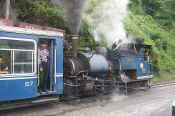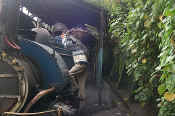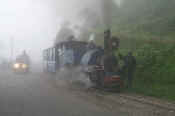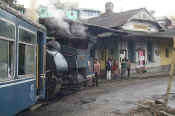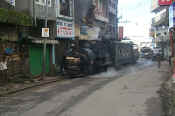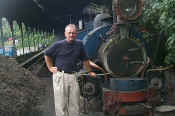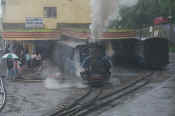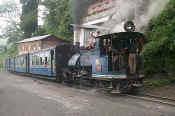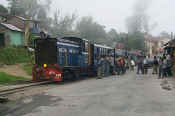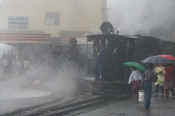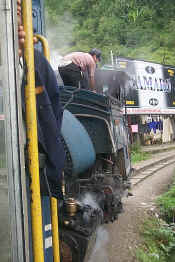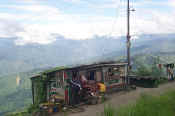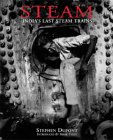My British Airlines flight
from London touched down on Calcutta airport 1500hrs on Saturday 1st
July, 2000. I had a good view of the city as we approached the tarmac. I was
admiring the tidy rice paddies below when the flight
crew announced that Malaria was evident throughout India. They
advised taking Malaria tablets. My last vaccination "shot"
was back in 1981 and that was for Tetanus. I had no Malaria tablets.
I stepped off the plane into 41C and 90% humidity, great weather for
mosquitoes I thought. Although the plane was less than one third
full, immigration took well over an hour. All the information
in each passport had to be recorded using ancient IBM dumb
terminals. With the passport in one hand, the information was
entered using one finger on the other hand.
Once through immigration and customs I headed for the money
exchange booth. No ATM machines at this airport. The money
exchange accepts Visa cards and travelers checks. The process
to change a T/C took about 20 minutes as there is a major amount of
paper work that goes with the process. A cash advance on a Visa
would probably take longer.
Cashed up, I went to the Official Pre-Paid Taxi Booth. This
pre-paid system saves any arguments with taxi drivers who like to
charge up to 3 or 4 times the normal fare. I'd booked a room at the
Fairlawn Hotel in Scudder street. This hotel is a leftover from the
days of the Raj and is run by an ex British Army major Edward Smith and his
wife Violet.
They've run the hotel since before the days of independence. The
tariff includes 3 meals a day, great curries.
With a population of 13 million it's
an interesting and colorful city. There's an eye opening sight
around every corner. Calcutta was once the gem of the British
Empire. Unfortunately it is still known throughout the
world for its poverty. Thanks to Mother Teresa and others, the
days hunger and people dying in the streets are a thing of the
past. While there don't miss a visit to the Victoria
Memorial on the Maidan, check out the tramway
system, ride in a man-hauled rickshaw, walk across the Howrah bridge
in peak hour and visit the famous black hole. A good place to
start is with the Government of India Tourist Office. They run
daily (except Monday) full day tours for 100 Rps. (US$2.40).
Tel 282 5813. Located at 4 Shakespeare Sarani.
I booked a berth, A/C 1st class sleeper on the Darjeeling Mail
to New Jalpaiguri, known as NJP where you make the connection with the toy
train which departs NJP at 9 a.m. The Darjeeling Mail
leaves from Sealdah station on platform 8 at 7.15 p.m nightly. I walked
around to the station the night before to see the train leave.
Sealdah station is very crowded, so go down there the night before
to get orientated or
give yourself plenty of time. (Calcutta to NJP on the mail takes 11
h 45 min to cover the 573 kms)
The daily NJP to Darjeeling trains were dieselised earlier
this year (2000) although as of July 2000 they were still
experiencing problems with the new diesel locos. While I was
in Darjeeling on the 3rd July 2000 the daily train from NJP
was cancelled due to the diesel failing. The next day the
train arrived from NJP steam hauled. I boarded the steam
hauled train the next morning for NJP, it was
delayed for 4 hours due to the diesel hauled NJP to Darjeeling
bound service derailing. I was told the diesels are too
powerful and run off the tracks on the sharp curves.
Although the NJP to Darjeeling service is diesel you can still
get plenty of steam action with the afternoon Darjeeling to
Kurseong and the morning Kurserng to Darjeeling services. But how
long these will remain steam hauled is anyone's guess. It's a
long trip in those small 2nd class carriages with hard seats
from NJP right through to Darjeeling. A good plan is to break
the journey at Kurseong and stay overnight in a hotel there and
continue your journey on the steam hauled local train into
Darjeeling the next morning. A good hotel in Kurseong is the
clean and comfortable, Kurseong Tourist Lodge. Its located at
the Darjeeling end of town, you can walk it in 10 minutes, buses and jeeps run
frequently and the fare is about 10 rps. The morning train to
Darjeeling departs at 6.40 a.m. While in Darjeeling I stayed
at the Dekeling Hotel, about 10 minutes walk from the station.
It's central to town and restaurants, is spotlessly clean,
great mountain and town views. The hotel is run by a friendly
and helpful Tibetan family. I used the Lonely Planet guide to
India.
The timetable below is taken from the Newmans Indian Bradshaw,
June 2000, railway timetable. I'm told that trains 1D and 4D
only run in the dry season. Also a daily tourist (steam) train
leaves Darjeeling at 11am running to Ghum and back to
Darjeeling. It's an all 1st class train and the fare is Rps
200 return. The return fare aboard the normal trains is Rps 6
return. The afternoon 10D, Darjeeling to Kurseong is listed in
the timetable to depart at 14.30 but departure was always
around 1600 hrs.
| Kms |
Up
1D
Pass
2nd |
3D
Pass
2nd |
9D
Pass
2nd |
Stations |
Dn
4D
Pass
2nd |
2D
Pass
2nd |
10D
Pass
2nd
|
|
7.30 |
9.00 |
|
NJP |
16.20 |
17.30 |
|
| 57 |
12.17 |
13.47 |
|
Kurseong |
11.00 |
12.22 |
|
|
12.27 |
13.57 |
6.40 |
Kurseong |
10.55 |
12.00 |
17.45 |
| 82 |
15.01 |
16.33 |
9.05 |
Ghum |
9.00 |
9.65 |
15.08 |
| 88 |
15.50 |
17.15 |
9.45 |
Darjeeling |
8.25 |
9.10 |
14.30 |
| |
|


